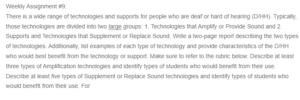Technologies that Support Deaf People with Hearing Problems -D-HH
Individuals with varied types of disabilities always face challenges in understanding or interacting with others daily. However, with modern technologies, students and people with hearing impairments use various devices developed to aid their hearing. Various learning institutions are currently providing students with hearing disabilities to improve their classroom experiences (Heward 313). When these students’ needs are addressed, they excel academically and become competitive in the job market. This report aims to analyze technologies that amplify sound and those that supplement sound and how students with hearing disabilities could benefit from them.
Technologies that Amplify or Provide Sound
Technologies that amplify sound also referred to as assistive learning devices, help amplify sound, especially in places where noise makes it audible. Examples include 1) hearing loop systems or induction loop systems, 2) automatic speech recognition, and 3) frequency-modulated (FM) systems. According to the American Speech and Language Hearing Association (ASHA), learning institutions with students with hearing impairments can connect these devices to the instructor’s microphone, directly connecting the system to the student hearing aid (Singleton and Jenny 336). This is made possible when an electric current is connected to a student’s hearing aid, helping impaired students to hear, especially when the class is large or noisy. Another example is the frequency-modulated (FM) systems that use radio signals that amplify voice regardless of a person’s distance.
Students Who Benefit from Technologies that Amplify or Provide Sound
Students who benefit from technologies that amplify or provide sound include those with hearing disabilities, those sitting far from the instructor, those who might miss class for certain reasons, and those in need of access to lecture materials. Technologies that amplify sound may benefit many students, especially those with varied hearing impairments. According to studies, these devices not only help learners with hearing disabilities by making sounds in noisy areas audible but also students who do not have disabilities (Singleton and Jenny 336). For example, students studying a second or third language will find it easier to follow instructions when captions are provided. Additionally, those struggling with note-taking or those who miss class will benefit because they can access instructional materials.
Technologies that Supplement or Replace Sound and Students Who Benefit from These Technologies
Technologies that supplement or replace sound are technologies for people with total hearing loss or other hearing difficulties. They help to drastically improve the lives of students and people with hearing loss. Compared to technologies that amplify or provide sound, sound supplements aim to help students with total hearing loss (Sousa et al. 56). Additionally, these technologies are connected to a public address system or sound system. One major characteristic of these devices is that they must contain a telecoil to help supplement the usefulness of the hearing aid. Examples include cochlear implants, alerting devices, and T-coils.
Technologies that supplement or replace sound are mainly used by students with hearing loss. For example, alerting devices help deaf students to know what is happening at an exact time by signaling a change in lesson or activity. Others, such as cochlear implants, are effectively used by children and adults to understand speech without relying on a sound interpreter (Heward 330). These devices also help students communicate with those with no hearing impairments without challenges. Therefore, these technologies help individuals, such as those with total deafness, children and adults who need to understand speech, and individuals without hearing disabilities who need to communicate with those with hearing impairments.
Works Cited
Heward, William L., Exceptional children: An introduction to special education. Pearson Education/Merrill/Prentice Hall, 2006.
Singleton, Jenny L., et al. “Everyday technology use among older deaf adults.” Disability and Rehabilitation: Assistive Technology 14.4 (2019): 325–332.
Sousa, Caio CS, Deller James, and Cassio L. Rodrigues. “Technologies For Educating Deaf Children Systematic.” (2019):25-56
ORDER A PLAGIARISM-FREE PAPER HERE
We’ll write everything from scratch
Question
Weekly Assignment #9:
There is a wide range of technologies and supports for people who are deaf or hard of hearing (D/HH). Typically, those technologies are divided into two large groups: 1. Technologies that Amplify or Provide Sound and 2.

Technologies that Support Deaf People with Hearing Problems -D-HH
Supports and Technologies that Supplement or Replace Sound. Write a two-page report describing the two types of technologies. Additionally, list examples of each type of technology and provide characteristics of the D/HH who would best benefit from the technology or support. Make sure to refer to the rubric below. Describe at least three types of Amplification technologies and identify types of students who would benefit from their use. Describe at least five types of Supplement or Replace Sound technologies and identify types of students who would benefit from their use. For

